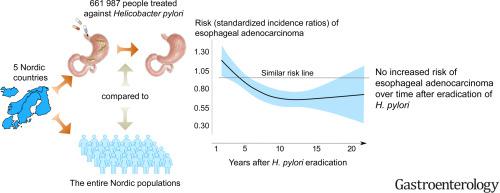当前位置:
X-MOL 学术
›
Gastroenterology
›
论文详情
Our official English website, www.x-mol.net, welcomes your feedback! (Note: you will need to create a separate account there.)
Risk of esophageal adenocarcinoma after Helicobacter pylori eradication treatment in a population-based multinational cohort study
Gastroenterology ( IF 29.4 ) Pub Date : 2024-03-19 , DOI: 10.1053/j.gastro.2024.03.016 Anna-Klara Wiklund , Giola Santoni , Jane Yan , Cecilia Radkiewicz , Shaohua Xie , Helgi Birgisson , Eivind Ness-Jensen , My von Euler-Chelpin , Joonas H. Kauppila , Jesper Lagergren
Gastroenterology ( IF 29.4 ) Pub Date : 2024-03-19 , DOI: 10.1053/j.gastro.2024.03.016 Anna-Klara Wiklund , Giola Santoni , Jane Yan , Cecilia Radkiewicz , Shaohua Xie , Helgi Birgisson , Eivind Ness-Jensen , My von Euler-Chelpin , Joonas H. Kauppila , Jesper Lagergren

|
infection is associated with a decreased risk of esophageal adenocarcinoma, and the declining prevalence of such infection might contribute to the rising incidence of this tumor. We examined the hypothesis that eradication treatment of increases the risk of esophageal adenocarcinoma. This population-based multinational cohort, entitled the “Nordic Eradication Project (NordHePEP)”, included all adults (≥18 years) receiving eradication treatment from 1995-2018 in any of the five Nordic countries (Denmark, Finland, Iceland, Norway, Sweden) with follow-up throughout 2019. Data came from national registers. We calculated standardized incidence ratios (SIR) with 95% confidence intervals (CI) by dividing the cancer incidence in the exposed cohort by that of the entire Nordic background populations of the corresponding age, sex, calendar period, and country. Analyses were stratified by factors associated with esophageal adenocarcinoma, i.e., education, comorbidity, gastroesophageal reflux, and certain medications. Among 661,987 participants who contributed 5,495,552 person-years after eradication treatment (median follow-up 7.8 years, range 1-24 years), 550 cases of esophageal adenocarcinoma developed. The overall SIR of esophageal adenocarcinoma was not increased (SIR=0.89, 95% CI 0.82-0.97). The SIR did not increase over time after eradication treatment, but rather decreased and was 0.73 (95% CI 0.61-0.86) 11-24 years after treatment. There were no major differences in the stratified analyses. The overall SIR of esophageal squamous cell carcinoma, calculated for comparison, showed no association (SIR=0.99, 95% CI 0.89-1.11). This absence on an increased risk of esophageal adenocarcinoma after eradication treatment of suggests eradication is safe from a cancer perspective.
中文翻译:

一项基于人群的多国队列研究中幽门螺杆菌根除治疗后食管腺癌的风险
感染与食管腺癌风险降低相关,这种感染患病率的下降可能导致这种肿瘤发病率的上升。我们检验了根除治疗会增加食管腺癌风险的假设。这个名为“北欧根除项目(NordHePEP)”的基于人群的多国队列包括 1995 年至 2018 年期间在北欧五个国家(丹麦、芬兰、冰岛、挪威、瑞典)接受根除治疗的所有成年人(≥18 岁) )并在 2019 年进行后续行动。数据来自国家登记册。我们通过将暴露队列中的癌症发病率除以相应年龄、性别、日历时期和国家的整个北欧背景人群的癌症发病率,计算了具有 95% 置信区间 (CI) 的标准化发病率 (SIR)。根据与食管腺癌相关的因素对分析进行分层,即教育、合并症、胃食管反流和某些药物。在根除治疗后贡献了 5,495,552 人年的 661,987 名参与者中(中位随访时间 7.8 年,范围 1-24 年),有 550 例发生食管腺癌。食管腺癌的总体SIR没有增加(SIR=0.89,95% CI 0.82-0.97)。根除治疗后,SIR 并没有随着时间的推移而增加,而是下降,治疗后 11-24 年为 0.73 (95% CI 0.61-0.86)。分层分析没有显着差异。经计算比较,食管鳞状细胞癌的总体 SIR 显示无关联(SIR=0.99,95% CI 0.89-1.11)。根除治疗后食管腺癌风险增加的情况表明,从癌症的角度来看,根除是安全的。
更新日期:2024-03-19
中文翻译:

一项基于人群的多国队列研究中幽门螺杆菌根除治疗后食管腺癌的风险
感染与食管腺癌风险降低相关,这种感染患病率的下降可能导致这种肿瘤发病率的上升。我们检验了根除治疗会增加食管腺癌风险的假设。这个名为“北欧根除项目(NordHePEP)”的基于人群的多国队列包括 1995 年至 2018 年期间在北欧五个国家(丹麦、芬兰、冰岛、挪威、瑞典)接受根除治疗的所有成年人(≥18 岁) )并在 2019 年进行后续行动。数据来自国家登记册。我们通过将暴露队列中的癌症发病率除以相应年龄、性别、日历时期和国家的整个北欧背景人群的癌症发病率,计算了具有 95% 置信区间 (CI) 的标准化发病率 (SIR)。根据与食管腺癌相关的因素对分析进行分层,即教育、合并症、胃食管反流和某些药物。在根除治疗后贡献了 5,495,552 人年的 661,987 名参与者中(中位随访时间 7.8 年,范围 1-24 年),有 550 例发生食管腺癌。食管腺癌的总体SIR没有增加(SIR=0.89,95% CI 0.82-0.97)。根除治疗后,SIR 并没有随着时间的推移而增加,而是下降,治疗后 11-24 年为 0.73 (95% CI 0.61-0.86)。分层分析没有显着差异。经计算比较,食管鳞状细胞癌的总体 SIR 显示无关联(SIR=0.99,95% CI 0.89-1.11)。根除治疗后食管腺癌风险增加的情况表明,从癌症的角度来看,根除是安全的。



























 京公网安备 11010802027423号
京公网安备 11010802027423号